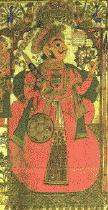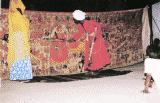 of Pābūjī
of Pābūjī
The epic of Pābūjī is an oral epic in the Rajasthani language, which is performed to the present day in the Indian state of Rajasthan. It is the subject of the book The epic of Pābūjī: a study, transcription and translation, by John D. Smith: Cambridge University Press, 1991, which has long been out of print and hard to obtain. This page gives basic information about the epic tradition; for more detail, see the complete electronic second edition of the book, made available here by kind permission of the copyright holders, the Faculty of Asian and Middle Eastern Studies (formerly Faculty of Oriental Studies), University of Cambridge. I am grateful to Dan Prior for his help with creating the bookmarks.
Also available here are a number of audio and video extracts from performances of the epic.
A highly reduced print version of The epic of Pābūjī, aimed more at the popular end of the market, was published in 2005 by Katha, New Delhi, and is still available.
Click on any of the pictures below to see a larger version.
The historical Pābūjī was a mediaeval Rajpūt prince; the earliest known version of his story is told in the Khyāta (chronicle) of Mũhato Naiṇasī, who flourished in the first half of the seventeenth century, and here he appears as a hero with miraculous powers, who both stole livestock and rescued the livestock stolen by others. Naiṇasī’s version of the story is translated as Appendix 1 in The epic of Pābūjī; the original Rajasthani text can be found here. Nowadays, his fame has a very different basis: he is widely worshipped as a deity by Rebārī herdsmen and others throughout the Rajasthan countryside; and he is served by low-caste Nāyak priests.
The most striking feature of the cult of Pābūjī is its principal ritual. Singer-priests (bhopos) of Pābūjī perform a liturgical epic telling of the life, death, and avenging of their hero-god; these performances take place at night, typically in front of a paṛ, a long narrative cloth-painting simultaneously depicting the events of the story and serving as a portable temple to the deity. For a brief synopsis of the epic story, click here.
Pābūjī was a Rāṭhoṛ Rajpūt, a member of what was to become the ruling line of Jodhpur. As the junior son of a junior son, he seems not to have been involved in the main territorial struggle, contenting himself with settling personal feuds and rustling livestock. Nowadays he is revered as a great hero throughout Rajasthan; but, more important, he is also worshipped as an incarnate god by many rural Rebārīs and Rajpūts. This claim to divinity is not accepted by higher-caste orthodox Hindus, and Pābūjī is not served by the brahmins, the priests of the “official” Hindu deities. Instead, his priests (bhopos) are drawn from the Nāyak caste, which is one of the scheduled castes of Rajasthan — the Nāyaks occupy a very low rank in the social hierarchy.
Pābūjī lived in the remote desert village of Koḷū, and in that village are to be found the only well-known conventional temples to him — two small temples within a single compound, where pūjā (worship) is offered to the deity. Small shrines, commemorative stones etc. abound, but, outside Koḷū itself, the absence of actual temples is conspicuous. There are two reasons for it: first, Pābūjī has yet to achieve sufficient prestige as a god to warrant the construction of pieces of architecture; and, second, many of his worshippers — in particular, many Rebārīs — are semi-nomadic, and are thus not in a position regularly to visit a temple in a fixed spot.
So, instead, the temple visits the worshippers. The bhopos are itinerant, and they carry their temple about with them. It takes the form of the paṛ, a cloth-painting about fifteen feet in length and between four and five feet in depth. In transit the cloth is kept rolled, rather than folded, presumably in order to avoid cracking the paint; by unexplained custom, it is always rolled from left to right, with the result that, after some time, the exposed right-hand edge begins to show signs of wear. The painting depicts the narrative of Pābūjī's life, his various exploits, and the vengeance taken by his nephew upon Jindrāv Khī̃cī, who killed him. Iconographically, it is extremely complex and intricate; its images are organised according to a strict logic which has more in common with a road-map than with a comic-strip.
 Pābūjī paṛ by Jaṛāvcand Josī of Bhīlwāṛā
Pābūjī paṛ by Jaṛāvcand Josī of Bhīlwāṛā
This very fine paṛ is dated 1938 A.D. and is the property of the Royal Tropical Institute, Tropenmuseum, Amsterdam, to whom I am grateful for permission to display it here. The right-hand edge has been damaged by wear: Ernst van de Wetering has supplied an indication of the content of the missing fragment.
Having arrived in a village or town, the bhopo erects his “temple” in a suitable public place shortly after nightfall. Since the paṛ functions as a temple, it is a holy object, and various ritual rules have to be observed: the ground beneath it must be swept clean and incense must be burnt before it. Other rituals also take place: the bhopo performs āratī (worship with a flame) before the central figure of Pābūjī, and devotees may make cash offerings to the god; if the donor is both sufficiently munificent and sufficiently literate, he may perhaps record his gift in writing on some unpainted spot on the cloth, while the bhopo blows a conch-shell, one blast for each rupee given. Then the liturgy can begin.
The liturgy of Pābūjī consists in the singing of an epic recounting the same narrative as is depicted on the paṛ. More precisely, it consists in the singing of as much of this epic as can be accommodated in twelve hours or thereabouts: since the epic is long, and pauses for food, rest, tobacco etc. are fairly frequent, it is never possible to sing the whole story — the assembled audience will request the bhopo to perform this or that episode, necessarily omitting parts of the narrative as a result. The performance goes on throughout the night, and terminates in the early morning (the paṛ is not supposed to be opened during the day).
 Parbū Bhopo performing the epic
Parbū Bhopo performing the epic
Parbū Bhopo of Mārwāṛ Junction and his wife Rukmā Devī performing the epic of Pābūjī for a small audience in their own village in 1989. Parbū is using the bow of his fiddle to point to a narrative detail on the paṛ while he chants the equivalent section of the epic story.
The singing of Pābūjī's epic may constitute a religious liturgy, but it is a fairly informal and cheerful event. The audience does not sit still or maintain a devout silence. In the course of performance the bhopo may crack jokes or make deliberate mistakes, and in return he may be chaffed by his listeners. He sings with his wife (bhopi) to the accompaniment of a spike-fiddle (ravanhattho); his wife holds an oil-lamp to illuminate details of the painted paṛ in the darkness. In between songs he declaims the narrative in a vigorous chant; during some songs he will dance, the bells round his ankles jingling and his red robe swirling about him. There is no doubt that the performance — the “reading of the paṛ”, as it is called — is an entertainment as well as a religious observance.
 Parbū dances as he sings the epic story
Parbū dances as he sings the epic story
Parbū Bhopo singing, playing the rāvaṇhattho fiddle and dancing as he performs the epic in front of his paṛ. Parbū is the bard from whom the version of the epic transcribed and translated in The epic of Pābūjī was recorded.
The two principal tools of a bhopo's trade are thus his fiddle (rāvaṇhattho) and his portable temple (paṛ). Normally he owns both, but he may borrow from friends or relatives. The fiddle he constructs for himself; the paṛ, however, is painted for him — at a price — by a professional painter (citero). The painters of paṛs have the lineage-name Josī; they are members of the Chīpā caste, whose traditional function is textile-printing. The Josī painters are, and appear to have always been, concentrated in South-East Rajasthan, almost entirely in the towns of Bhīlwāṛā and Shāhpurā; at the present day it is reckoned that there are seventeen or eighteen of them involved in painting paṛs.
 The paṛ painter Śrīlāl Jośī at work
The paṛ painter Śrīlāl Jośī at work

Śrīlāl Jośī is one of the best-known living paṛ painters. These two pictures show him at work on a Pābūjī paṛ at his home in Bhīlwāṛā. He is applying green paint to the top left-hand corner of the cloth, where the image of the elephant-headed god Gaṇeśa can be seen. Yellow and flesh-colour have already been filled in. The painters apply colours one at a time to the entire cloth, starting with the lightest; the black outline round each figure is added last.